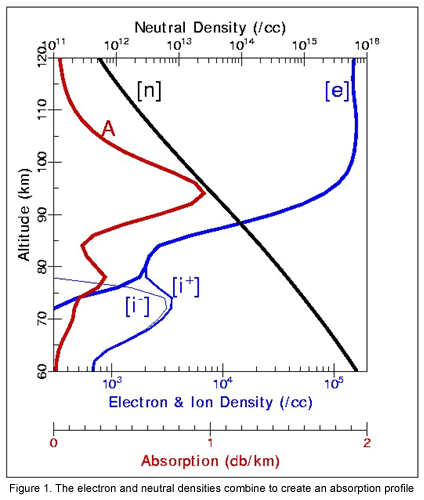ABBYNormal
Version: 1.2051014The ABsorption BY the D and E Region of HF Signals with NORMAL Incidence or the ABBYNORMAL Model calculates the D and E region (60-150 km) ionization sources and ion-neutral chemistry to obtain an electron density profile. The physics-based models within AbbyNormal are identical to the Data-Driven D-Region model (DDDR), which was created under NASA/Living-with-a-Star funding (NASW-02108). The AbbyNormal Model (DDDR) has simplified D region chemistry. The number of minor neutral and ion species used within the DDDR is small compared to the enormous number generally present. However, the goal of the DDDR is to provide an electron density profile for the HF absorption calculation. Thus, much of the detail of the ion chemistry is ignored, but enough remains to include all important source and loss processes to obtain a good electron density profile.
The AbbyNormal electron density profile and MSIS neutral atmosphere are used to calculate HF signal loss in decibels per kilometer (Figure 1). The loss per kilometer is the integrated for the vertical transit. The E region is included because approximately 10% of the non-deviative absorption occurs in the E region.
More Detail: The AbbyNormal model is a multi-level model, which includes the following components:
- An empirical neutral atmosphere model (MSISE00)
- Physics-based model of the electron-ion densities through the D and E region altitudes
- High Frequency (HF) signal absorption calculation for HF ray paths through the ionosphere
- Ionospheric conductivity calculation for vertically integrated Pedersen and Hall conductivities.
AbbyNormal combines these 4 components to predict the attenuation of an HF signal in transit through the earth's ionosphere. The attenuation depends on the electron and neutral density in the D and E regions. The electron gas of the ionosphere 'sees' the electromagnetic wave and damps the signal magnitude if the electron-neutral collision rate is similar to the signal frequency. The electron-neutral collision rate is near HF frequencies (1 to 30 MHz) at D and E region altitudes (60-105 km). Most HF signal propagation codes include this 'non-deviative' signal absorption by treating the D region as a thin shell, which attenuates a trans-ionospheric signal. The D-region absorption is often determined through empirical relations with solar angle dependence (1/cos c), HF frequency (1/f 2), and solar indices (F10.7). AbbyNormal uses physics-based models and formulate to calculate the attenuation.
We assume straight-line propagation within AbbyNormal for the HF frequencies of interest (3-50 MHz) because the low densities of the D region do not affect the HF propagation direction. The absorption calculation is performed for a single vertical transit of the HF signal, which is then adapted to non-vertical propagation by using the angle of incidence (1/cos I) for oblique transit absorption.
Figures

Inputs
Remote sensing SMEI data from CASS/USU (Space Environment Corp.)
Outputs
Vertically integrated absorption values in decibels for 5, 10, and 15 MHz HF signals. Vertically integrated of Hall conductivity in mhos. Vertically integrated of Pedersen conductivity in mhos.
These outputs are two-dimensional global maps. These are provided for the whole day requested at 30 minute intervals. The format of each files provides the geo-latitude and geo-longitude node information with the global output values. The files can be read using FORTRAN code:
READ(1,'(8X,I6)')NX
READ(1,'(1P,6E12.4)')(GLON(I),I=1,NX)
READ(1,'(8X,I6)')NY
READ(1,'(1P,6E12.4)')(GLAT(J),J=1,NY)
READ(1,'(8X,2I6)')NX,NY
READ(1,'(1P,6E12.4)')((VALUE(I,J),I=1,NX),J=1,NY)
Model is time-dependent.
Domains
- Global Ionosphere
Phenomena
- HF Signal Absorption
Code
Code Languages: Fortran
Relevant Links
Contacts
- J Vincent Eccles, CASS USU (Model Developer)
- Jia Yue, NASA/GSFC (CCMC Model Host)
- Masha Kuznetsova, NASA GSFC CCMC (CCMC Model Host)
Publication Policy
In addition to any model-specific policy, please refer to the General Publication Policy.